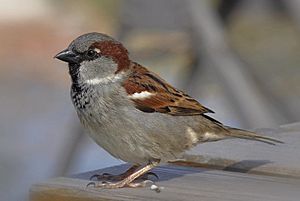Neognathae facts for kids


Neognaths (pronounced Nee-oh-nath-s), also known as Neognathae, are a huge group of birds. In fact, almost all living birds you see today belong to this group! The only birds that aren't neognaths are the tinamous and the large, flightless ratites like ostriches and emus. Those birds belong to a different, smaller group called Palaeognathae.
There are nearly 10,000 different species of neognaths! Scientists believe the first neognaths appeared around 90 million years ago, near the end of the Cretaceous period. Since then, they have spread out and changed a lot, leading to the amazing variety of birds we see all around us. This group includes the Passeriformes, also known as perching birds, which are the largest group of land animals with backbones. They make up about 60% of all living birds! To give you an idea, there are more than twice as many perching bird species as there are rodents, and about five times as many as bats. Even some very unique birds, like the puzzling hoatzin, are part of the neognath family.
Neognath birds have special features in their bones. For example, the bones in their "hands" (called metacarpals) are fused together, and their third finger is longer than in other birds. They also have 13 or fewer bones in their back (called vertebrae). One of the main differences between neognaths and palaeognaths is the structure of their jawbones. The name "Neognathae" actually means "new jaws."
Understanding Bird Families
Scientists work hard to figure out how all the different kinds of birds are related to each other. They use clues from fossils (ancient remains) and by studying the DNA of living birds. This helps them create a "family tree" for birds, showing which groups are closely related and which branched off a long time ago.
Here are some of the major groups within the Neognaths:
- Galloanserae: This group includes familiar birds like Galliformes (chickens, turkeys, pheasants) and Anseriformes (ducks, geese, swans).
- Neoaves: This is a very large group that contains most of the other living birds. It's further divided into many smaller branches.
- Strisores: This group includes birds like hummingbirds and nightjars.
- Columbaves: This branch contains birds such as pigeons (Columbiformes), turacos (Musophagiformes), and cuckoos (Cuculiformes).
- Water Birds: Many water-loving birds are found here, including Gruiformes (rails and cranes), Charadriiformes (shorebirds and gulls), Phoenicopteriformes (flamingos), and Podicipediformes (grebes).
- Land Birds: This huge group includes many birds that live on land.
- Birds of Prey: This includes Accipitriformes (hawks, eagles) and Cathartiformes (New World vultures).
- Owls: The Strigiformes are well-known for being active at night.
- Colorful Birds: Groups like Coraciiformes (kingfishers, bee-eaters) and Piciformes (woodpeckers, toucans) are known for their bright colors.
- Parrots and Perching Birds: The Psittaciformes (parrots) and Passeriformes (perching birds like sparrows, robins, and crows) are among the most diverse groups.
See also
 In Spanish: Neognatos para niños
In Spanish: Neognatos para niños

